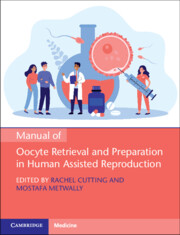Book contents
- Manual of Oocyte Retrieval and Preparation in Human Assisted Reproduction
- Manual of Oocyte Retrieval and Preparation in Human Assisted Reproduction
- Copyright page
- Contents
- Contributors
- Chapter 1 The Ovary: A General Overview of Follicle Formation and Development
- Chapter 2 Monitoring of Ovarian Stimulation
- Chapter 3 Theatre Design, Equipment and Consumables for Oocyte Retrieval
- Chapter 4 Conscious Sedation and Analgesia for Oocyte Retrieval
- Chapter 5 Practical Clinical Aspects of Oocyte Retrieval
- Chapter 6 Challenges during Oocyte Retrieval
- Chapter 7 Complications of Oocyte Retrieval
- Chapter 8 The Nurse’s Role during Oocyte Retrieval
- Chapter 9 Laboratory Design, Equipment and Consumables for Oocyte Retrieval
- Chapter 10 Quality Management Requirements for Oocyte Collection
- Chapter 11 Morphological Assessment of Oocyte Quality
- Chapter 12 Oocyte Preparation for Conventional In Vitro Fertilisation and Intracytoplasmic Sperm Injection
- Chapter 13 Oocyte Retrieval: The Patient’s Perspective
- Index
- Plate Section (PDF Only)
- References
Chapter 2 - Monitoring of Ovarian Stimulation
Published online by Cambridge University Press: 09 November 2022
- Manual of Oocyte Retrieval and Preparation in Human Assisted Reproduction
- Manual of Oocyte Retrieval and Preparation in Human Assisted Reproduction
- Copyright page
- Contents
- Contributors
- Chapter 1 The Ovary: A General Overview of Follicle Formation and Development
- Chapter 2 Monitoring of Ovarian Stimulation
- Chapter 3 Theatre Design, Equipment and Consumables for Oocyte Retrieval
- Chapter 4 Conscious Sedation and Analgesia for Oocyte Retrieval
- Chapter 5 Practical Clinical Aspects of Oocyte Retrieval
- Chapter 6 Challenges during Oocyte Retrieval
- Chapter 7 Complications of Oocyte Retrieval
- Chapter 8 The Nurse’s Role during Oocyte Retrieval
- Chapter 9 Laboratory Design, Equipment and Consumables for Oocyte Retrieval
- Chapter 10 Quality Management Requirements for Oocyte Collection
- Chapter 11 Morphological Assessment of Oocyte Quality
- Chapter 12 Oocyte Preparation for Conventional In Vitro Fertilisation and Intracytoplasmic Sperm Injection
- Chapter 13 Oocyte Retrieval: The Patient’s Perspective
- Index
- Plate Section (PDF Only)
- References
Summary
Monitoring of ovarian stimulation plays a key role in the recruitment of mature oocytes, which in turn leads to better fertilisation rates and embryo development.
- Type
- Chapter
- Information
- Publisher: Cambridge University PressPrint publication year: 2022

